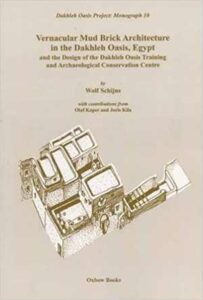نام کتاب: Vernacular Mud Brick Architecture In The Dakhleh Oasis, Egypt And The Design Of The Dakhleh Oasis Training And Archaeological Conservation Centre
نویسنده: Wolf Schijns و Olaf E. Kaper و Joris Kila
ویرایش: ۱
سال انتشار: ۲۰۰۸
کد ISBN کتاب: ۱۸۴۲۱۷۰۵۹۷,
فرمت: PDF
تعداد صفحه: ۵۶
حجم کتاب: ۸ مگابایت
کیفیت کتاب: Scan – OCR
انتشارات: Oxbow Books Limited
Description About Book Vernacular Mud Brick Architecture In The Dakhleh Oasis, Egypt And The Design Of The Dakhleh Oasis Training And Archaeological Conservation Centre From Amazon
More than one third of the world’s population lives in houses made of unfired earth bricks or stamped earth, materials also known as mud brick, adobe, terre crue, pisé, or rammed earth. Houses in the middle east have been made out this material for at least 10,000 years, but in many places this form of architecture is slowly being superceded by more recent building techniques using reinforced concrete and concrete blocks. This study contains a description of the remaining mud brick architecture in several villages in the Dakhleh Oasis in Egypt. It includes a brief history of mud brick, a discussion of the distinct local building techniques of the Oasis, and three architectural case studies of traditional mud brick houses in the Oasis, and it has many plans and photographs of local houses. The study was carried out as preparation for the design and construction of an archaeological working and training centre in the Dakhleh Oasis, which has been made according to the local traditions in mud brick vernacular. It is based on a field trip carried out in 1997 by Wolf Schijns (architect), Margriet Schijns (architect), Olaf E Kaper (Egyptologist) and Joris D Kila (art historian).
درباره کتاب Vernacular Mud Brick Architecture In The Dakhleh Oasis, Egypt And The Design Of The Dakhleh Oasis Training And Archaeological Conservation Centre ترجمه شده از گوگل
بیش از یک سوم جمعیت جهان در خانههایی زندگی میکنند که از آجرهای خاکی پخته نشده یا زمین مهر و موم شده ساخته شدهاند، موادی که بهعنوان آجر گلی، خشت، خاکستر، پیسه یا خاک کوبیده نیز شناخته میشوند. خانههای خاورمیانه دستکم ۱۰۰۰۰ سال است که از این ماده ساخته شدهاند، اما در بسیاری از مکانها این شکل از معماری به آرامی با تکنیکهای ساختمانی جدیدتر با استفاده از بتن مسلح و بلوکهای بتنی جایگزین میشود. این مطالعه شامل توصیفی از معماری خشتی گلی باقیمانده در چندین روستا در واحه دخله در مصر است. این شامل تاریخچه مختصری از آجر گلی، بحث در مورد تکنیک های متمایز ساختمان محلی واحه، و سه مطالعه موردی معماری خانه های آجری سنتی در واحه است، و دارای پلان ها و عکس های زیادی از خانه های محلی است. این مطالعه بهعنوان آمادهسازی برای طراحی و ساخت یک مرکز کار و آموزش باستانشناسی در واحه دخله انجام شد که بر اساس سنتهای محلی به زبان بومی آجر گلی ساخته شده است. این بر اساس سفر میدانی است که در سال ۱۹۹۷ توسط Wolf Schijns (معمار)، Margriet Schijns (معمار)، Olaf E Kaper (مصر شناس) و Joris D Kila (مورخ هنر) انجام شد.
[box type=”info”]![]() جهت دسترسی به توضیحات این کتاب در Amazon اینجا کلیک کنید.
جهت دسترسی به توضیحات این کتاب در Amazon اینجا کلیک کنید.![]() در صورت خراب بودن لینک کتاب، در قسمت نظرات همین مطلب گزارش دهید.
در صورت خراب بودن لینک کتاب، در قسمت نظرات همین مطلب گزارش دهید.

